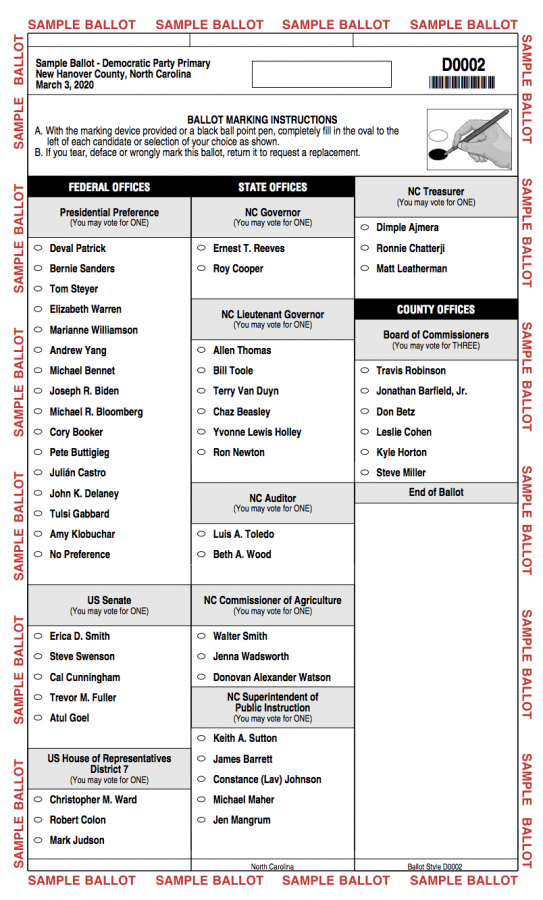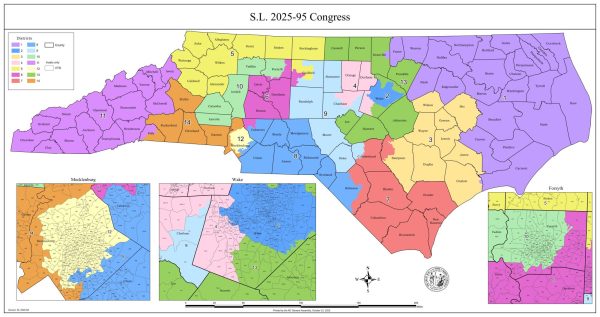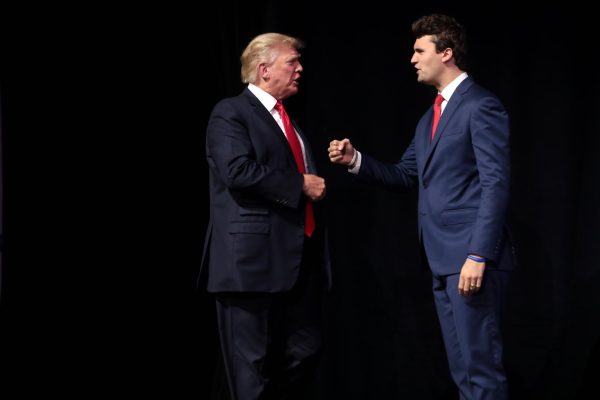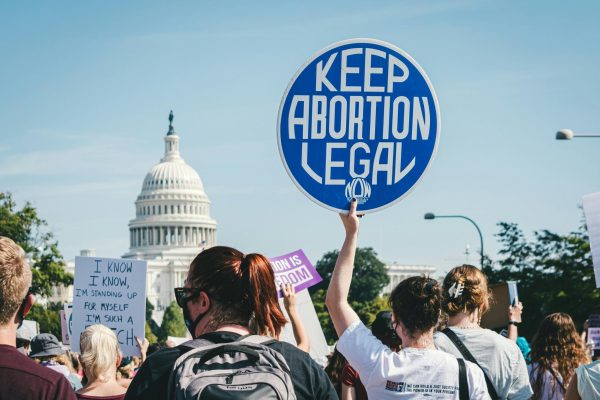Confusion amongst democratic primary ballot candidates
North Carolina State Board of Elections
The sample ballot for the New Hanover county 2020 primary elections.
We are in the midst of the 2020 primary elections and that means there are many decisions to be made between now and the end of the voting period. North Carolina’s early voting period is running from Feb. 13 to 29 with the official voting day being held on March 3. I voted last Friday, and much to my own confusion, there were candidates listed that had dropped out prior to the start of the primaries.
Per the sample democratic party primary ballot for New Hanover County, the list of candidates included Deval Patrick, Bernie Sanders, Tom Steyer, Elizabeth Warren, Marianne Williamson, Andrew Yang, Michael Bennet, Joseph R. Biden, Michael R. Bloomberg, Cory Booker, Pete Buttigieg, Julián Castro, John K. Delaney, Tulsi Gabbard, Amy Klobuchar and No Preference.
The only two candidates who also dropped out and were not still listed were Kamela Harris and Beto O’Rourke. Harris dropped out in early December and O’Rourke in early November. They likely were not listed (unlike other dropout candidates) because they dropped out prior to the ballots being printed.
Although, according to the New York Times, of those 16 options, only eight are actually still in the race—Sanders, Steyer, Warren, Biden, Bloomberg, Buttigieg, Klobuchar and Gabbard.
So, why are there still 16 candidates to vote for? It is one thing to write-in their name (although you are not given the write-in option until the general election on Nov. 3), but the fact that they are still listed gives off the notion that they are still legitimately in the race—which they are not due to the fact that they dropped out.
The primaries began Feb. 3 with the Iowa caucus, and at that point, Patrick (dropped out Feb.12), Yang (dropped out Feb. 11), Bennet (dropped out Feb. 11) and Booker (dropped out Jan.13) were still in the race. So, it would make sense to still have those four candidates listed on the ballots because, at that point, it would be a waste to reprint new ballots for the remaining primary elections.
On the other hand, Williamson (dropped out Jan.10) and Castro (dropped out Jan.2) should not have been listed, given that they dropped out almost a month before voting began. You could make a case for Delaney (dropped out Jan.31) still making the ballot since he did not drop out until three days prior to the start of voting.
It all comes down to how far in advance the ballots are printed and the sheer number of ballots that need to be printed for each specific state.
“Ballots for the Primary were printed and made available to the public on Jan. 13 2020,” wrote Julius Richards, Elections Support Technician, for the N.C. State Board of Elections.
The Pew Research Center found that over 57.6 million people voted in the 2016 primaries. That is a lot of ballots.
Runbeck Election Services, a Phoenix-based company, printed about 14 million ballots for 16 states in the 2018 midterm elections according to an article from KGUN. Granted they only served 16 states, other companies are involved in the ballot preparation and printing process.
So, ballots are being printed almost a month prior to the election day. Meaning there is little-to-no room to remove candidates who have dropped out between the printing date and the election day.
For consistency and fairness purposes, I am sure that all the ballots need to list the same presidential candidates, but you are also voting on state and county offices as well. So, depending on where you are voting, your ballot is different based on your jurisdiction. But, I could not find evidence stating that ballots had to list all the same primary presidential candidates. Would it really cause any harm to keep the ballots updated for whenever a candidate dropped out?
The Voice of OC reported that California started sending out their mail-in ballots on Feb. 3, a month ahead of voting day, which meant the ballots had to be ready and approved before then, leaving no room for any change in candidates the month leading up to voting day.
At the end of the day, it seems that the confusion of listing dropped out candidates on the primary ballots comes down to a matter of resources and money. To reprint thousands upon thousands of ballots to not include candidates who have dropped out (especially ones who dropped out close to election day) would take a lot of money and resources.
Deciding who to vote for can be a hard enough decision, but when there are candidates listed who have already dropped out prior to voting day, it can become even more confusing and hard to decide who to chose. One thing you can do as a voter is to become more informed. Before heading to the polls this March (or whenever your primaries are), make sure to do your research on the candidates and check if they are still even legitimate candidates anymore.









Chuck Ball • Feb 26, 2020 at 8:04 am
Veronica, thank you for this information. A bunch of us old geezers were wondering who were actually viable candidates. Keep up the good work!